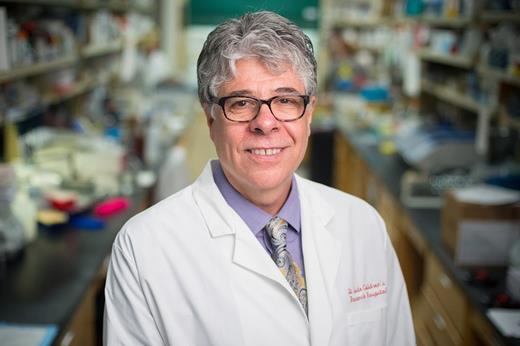Brian Sorrentino, a physician scientist and a pioneer in hematopoietic stem cell (HSC) gene therapy, died on November 16, 2018, at age 60 years. Dr. Sorrentino was born and raised in upstate New York and attended Union College in Schenectady. He graduated from medical school at The State University of New York Upstate Medical Center in Syracuse and completed an internal medicine internship at University of North Carolina in Chapel Hill. In a decision that shaped the next 30 years of his career, he relocated to the National Institutes of Health in 1988 to begin intensive training in gene therapy and hematology research in the laboratory of Dr. Arthur Nienhuis at the National Heart, Lung, and Blood Institute (NHLBI), also completing hematology-oncology fellowship training at the NHBLI and the National Cancer Institute. Initially, Dr. Sorrentino characterized transcriptional regulatory elements in the β-globin gene locus, which informed future work to generate hemoglobinopathy gene therapy vectors. In 1990, he reported in Science that retroviral transfer of the multidrug resistance 1 gene into bone marrow cells conferred in vivo resistance to taxol, initiating a series of studies to optimize HSC gene therapy through positive selection of viral vector-transduced cells. This work led to the identification of the membrane transporter ABCG2, which marks a variety of tissue stem cells and is responsible for the “side-population” phenotype used for the flow-cytometry purification of stem cells.
In 1993, Dr. Sorrentino relocated to St. Jude Children’s Research Hospital and along with Dr. Nienhuis and other investigators, focused on advancing the nascent field of gene therapy for blood diseases and cancer. Leading his own research group, Dr. Sorrentino became interested in gene therapy for congenital immunodeficiencies and published a 1998 article in Nature Medicine showing that the immunodeficiency associated with JAK3 ablation in mice could be cured by retroviral transfer of the intact gene into mutant bone marrow cells. This provided the first demonstration that an animal model of human disease could be cured by HSC gene therapy. When leukemia caused by retroviral vector insertional mutagenesis occurred in the first human gene therapy trial for X-linked severe combined immunodeficiency (X-SCID), Dr. Sorrentino focused his research on safety improvement, including novel insulated lentiviral vectors and improved assays to quantify insertional mutagenesis. He also pioneered methods to generate vector particles from a stable producer line to streamline manufacturing.
Dr. Sorrentino’s recent research is the most impressive of his career. Working with collaborators at St. Jude, the National Institute of Allergy and Infectious Diseases (NIAID) and the University of California at San Francisco (UCSF), he developed improved gene therapy protocols for X-SCID. Advances over prior approaches included the first in-human use of a novel lentiviral vector producer line, along with low-dose busulfan for bone marrow conditioning to improve the engraftment of vector-transduced HSCs. The results so far are groundbreaking. As reported in Science Translational Medicine in 2016, five older patients with X-SCID with persistent immune dysfunction despite haploidentical HSC transplantation in infancy treated at NIAID showed sustained high-level vector marking in T, B, and NK cells, with restored cellular and humoral immunity as well as clinical improvement in many of the patients. More recently, similar results were obtained at St. Jude after treating eight infants with newly diagnosed X-SCID. The high-level hematopoietic cell vector marking and the degree of humoral immunity rescue observed in Dr. Sorrentino’s studies are unprecedented.
Dr. Sorrentino was a dedicated mentor and colleague. He trained many students and postdoctoral fellows, many of whom moved onto successful positions in academia and the pharmaceutical industry. As Director of Experimental Hematology at St. Jude since 2004, he recruited several junior faculty and helped them establish successful academic careers. As leader of the X-SCID gene therapy trial, he supervised and coordinated a large team of St. Jude laboratory scientists and clinical researchers and collaborators at NIAID and UCSF who respected him greatly.
Dr. Sorrentino died from lung cancer that arose as a late effect of the high-dose radiation and chemotherapy he received for the treatment of Hodgkin lymphoma, which he overcame as a teenager. As a childhood cancer survivor, he was proud to work at St. Jude. Although he had numerous treatment-related complications in the decades following cure of his Hodgkin disease, he dealt with them without complaint. Rather, he focused on the relentless pursuit of successful gene therapy, leading his research group, providing mentorship, and growing the field of gene therapy for blood diseases via volunteering his prodigious energies to professional societies such as ASH and the American Society for Gene and Cell Therapies.
Dr. Sorrentino was also a devoted and adoring husband to his wife Suzanne, father to Emily and Joseph, and grandfather to Ruby. He was a devoted, warm, and supportive friend and colleague with a wry sense of humor and a laugh that lit up the room. He was a lively, well-informed, open-minded debater on many topics. He enjoyed fast cars (especially racing his red 2009 Corvette), playing blues guitar, listening to music of many kinds, and reading nonfiction, particularly history and politics. He pursued his research and hobbies with enormous zeal and was filled with deep, intricate knowledge of each, which he communicated enthusiastically. Brian maintained close relationships with professional colleagues from every phase of his training and career, and personal friends from every neighborhood he ever called home. We will miss our friend and colleague, who lived a happy, productive life but died way too young. To describe our loss in the words of the Grateful Dead, one of Brian’s favorite bands, “Such a long, long time to be gone and a short time to be there.”
Respectfully,
– Mitchell J. Weiss, Cynthia E. Dunbar, David M. Bodine, John Tisdale, and Arthur W. Nienhuis

